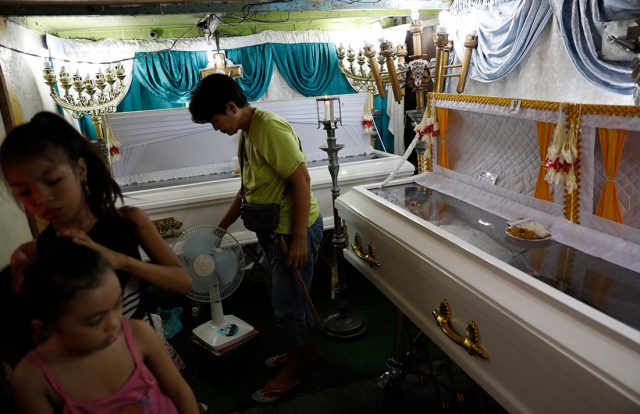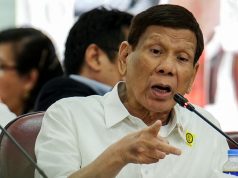
BARANGAY 19, Manila — The police report was clear. Anti-drug officers shot and injured three men in this poor district of the Philippine capital, then “rushed” them to hospital where they were pronounced dead on arrival.
But security camera footage obtained by Reuters tells a different story of what happened just after midday on October 11 in Barangay 19, Tondo, Manila.
It shows that police took at least 25 minutes to haul away the men they had shot. The victims show no signs of life; police are seen carrying them by their arms and legs and loading their limp bodies onto pedicabs to take them to hospital.
EXPLORE THE KILLINGS IN AN INTERACTIVE GRAPHIC: CLICK HERE
The footage casts new doubts on the official accounts of police killings in President Rodrigo Duterte’s 17-month war on drugs.
In June, Reuters revealed that police have shot hundreds of people during anti-drug operations, then taken them to hospitals where they are declared dead on arrival. Police say they’re trying to save lives. Bereaved relatives and other witnesses allege police are sending corpses to hospitals to disrupt crime scenes and cover up extrajudicial killings.
Police have shot dead at least 3,900 people in anti-narcotic operations since Duterte took power in June 2016 — always in self-defense, police say. Human rights activists blame police for thousands more killings attributed to vigilantes, but authorities deny any involvement.
READ MORE OF REUTERS’ INVESTIGATION INTO DUTERTE’S WAR: CLICK HERE
A witness to the Barangay 19 killings told Reuters that the three men were executed and not, as the police claim, shot in self-defense. Police say they only use deadly force in self-defense, but a series of investigations by Reuters suggest they are summarily executing people.
The security camera footage not only contradicts the police account of the Barangay 19 killings. It also provides further evidence of another drug-war tactic: the disabling of surveillance cameras at crime scenes by the police.
In the footage, filmed simultaneously by four security cameras, an officer is seen turning the camera that captured the action away from the scene after the shooting.
WATCH THE REUTERS VIDEO FROM CCTV FOOTAGE (WARNING: Graphic Images)
The police understand the dangers posed by such footage, which can expose their actions. An active-duty commander involved in the drug war told Reuters earlier this year that police collude with local officials to unplug security cameras in areas where they plan to carry out a drug-war killing.
Reuters has obtained footage from all four security cameras, each capturing the episode from a different angle. Together, the cameras provide a unique record of a police operation from start to finish. Some of the Barangay 19 footage was previously aired by Philippine broadcaster GMA.

“The operation was legitimate,” said Santiago Pascual, the commander of the station that conducted the raid, in a statement to Reuters. A station investigation showed that his officers had followed correct operational procedure, said Pascual, and eyewitness testimony that they had opened fire on unarmed men was “untrue and unfounded.”
Police carried out the October 11 raid a day after Duterte ordered them to leave anti-drug operations to the state-run Philippine Drug Enforcement Agency.
The October memo marked the second time that Duterte has publicly told police officers to stop waging his drug war. He announced a halt to their operations in late January after news emerged that police had kidnapped and murdered a South Korean businessman. He lifted that ban one month later, saying drugs were returning to the streets.
In his latest order, Duterte said he wanted “to bring order to the operation/campaign against illegal drugs, thus pinpointing precise accountability.”
The announcement came amid escalating public criticism of alleged police atrocities. Recent surveys by Manila-based pollster Social Weather Stations have shown rising distrust of the police and unease with their brutal methods, which have been criticized by the influential Catholic Church.
The circulation online of security camera footage of police operations and vigilante killings has spurred public disquiet with Duterte’s bloody anti-drug campaign. Outrage followed the August release of video that seemed to back up eyewitness accounts of how teenager Kian Loyd delos Santos was killed that month.
VIEW AN INTERACTIVE GRAPHIC ON KIAN DELOS SANTOS’ KILLING: CLICK HERE
Police said they shot the 17-year-old in self-defense after he opened fire. Eyewitnesses said police took the unarmed boy to a trash-filled alley in northern Manila and shot him in the head. Footage emerged showing two officers marching a figure toward the spot where delos Santos’ body was found. His funeral procession turned into the biggest protest yet against the drug war.
The officers in the Barangay 19 footage belong to an anti-drug unit from Police Station 2 in Manila, according to a police report of the incident. Of the 15 officers who appear clearly on the footage, only one is wearing a mask.
The report said Rolando Campo, 60, sold drugs to an undercover officer, who signaled for back-up. Campo “sensed the presence” of the police officers and ordered his two associates — Sherwin Bitas, 34, and Ronnie Cerbito, 18 — to draw their guns and open fire on them, the report said.
The police retaliated, leaving the three men “fatally wounded,” it said.
But the footage shows Campo chatting with people in the neighborhood in the minutes before the police arrive, and not, as the report said, selling drugs to an undercover officer.
The police operation doesn’t seem to be undercover. The footage shows mainly plainclothes officers, most of them visibly armed and some wearing body armor, entering the area through the alley on which Campo and Bitas lived. The officers pass in full view of the victims’ house seven minutes before the shooting starts.

Arlene Gibaga, Bitas’ wife, told Reuters that she witnessed the shooting and the three men were unarmed. “We don’t have the money for guns,” said Gibaga, who has three young children with Bitas. She said her husband didn’t deal drugs.
Police detained the men in an alley next to her house, she said, and asked her to get Bitas’ ID. When she produced it, said Gibaga, one officer shouted “Positive! Positive!” and then the officers fired on Bitas.
“Don’t do that to my husband!” she screamed, as the police shot Bitas. “I will report you! There are CCTV cameras here!”
One of the officers then aimed his gun at Gibaga and ordered her inside, she said.
The footage doesn’t show the police shooting the three men, but does show an officer appearing to open fire on an unseen target. Campo then falls backwards into the frame, his body hitting the ground. His arms move for a while before resting motionless.
Less than a minute later, the camera that captured the scene of the shooting is effectively put out of action: someone turns it to face the wall. A second camera shows a police officer reaching up and turning it away. It’s unclear why the officer only disables the camera after the shooting.
Station commander Pascual said the camera was averted for a “valid security reason” and to ensure the operation wasn’t compromised. His statement reiterated the police report’s version of events — “that the suspects first drew firearms and shot the operatives,” who returned fire in self-defense.
Later that day, at Police Station 2, Gibaga said officers told her it was useless to complain. “It’s the government you will be fighting against,” she recalled one officer saying. “Don’t get angry at us. We are just following orders.”
Palace: ‘We do not tolerate police violence’
After this Reuters report came out, presidential spokesperson and human rights adviser Harry Roque “assured” that Duterte “will not tolerate any abuses that may be committed by some personnel of the PNP.”
“Again, the Palace position is we do not tolerate police violence, brutality or killing,” Roque told reporters on Tuesday.
Also, Roque urged lawyers to help in gathering evidence against those being accused of the crime so there would be basis to investigate the allegations.
“Hinihimok ko ‘yong mga abugado, tumulong kayo sa proseso pagkalap ng ebidensya dahil kung wala naman pong magrereklamo paano tayo mag-iimbestiga?” he said.
“Paano tayo magpaparusa? Hindi po sapat ‘yong press release na may ganitong reklamo [How can we punish? Press release isn’t enough for these kinds of complaint],” added Roque.









